Did you know that deep within the 9/11 memorial in New York City is a repository for the remains of unidentified 9/11 victims?
When the first of the Twin Towers was struck at 8:46 a.m., I was in my bed- an innocent 11-year-old girl who didn’t truly understand what “terrorism” means. Coming out of my room, I was walking down the hall when Mom’s voice rang out the news. It took me a minute to understand the devastation in her tone, to wrap my head around the fact that someone could take a plane full of innocent people and put it through a building, with the express intent of killing people he did not know, who had never done anything to him.
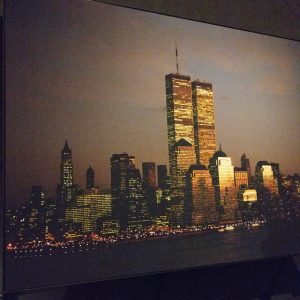
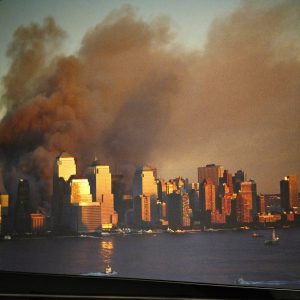
We did not have cable, only a TV with VCR player that was used once a week for movie day – the extent of our allowed screen time. Mom relied on the radio to hear the goings-on of the world. We knew that an historic event was occurring, so Mom loaded us up in the car and sped to a friend’s house, where we watched the news for the next several days with growing horror.
My head spun as I realized that people were jumping out of the towers. I tried to picture myself standing on the ledge, caught between suffocating heat and dizzying height. I am now 28 years old, and to this day cannot fathom making such a choice.
The National September 11 Memorial & Museum brought this all back, in a beautiful mixture of tribute to the emergency responders, to the victims themselves, and to our American strength. There were many things I did not expect- voice recordings of airport officials during the initial confusion, the message of a guy who called his wife from one of the planes, pieces of paper – half-burned – from the towers themselves, the shoes of one of the firefighters.
The museum is huge. Len (my brother) and I gave ourselves 2.5 hours to go through it, and we wished we had another hour. Located beneath the footprints of the towers themselves, the tour starts off slowly, as you go down the ramp which houses pictures and recordings of victims and witnesses, and “missing” posters – many of people who still have not been recovered.

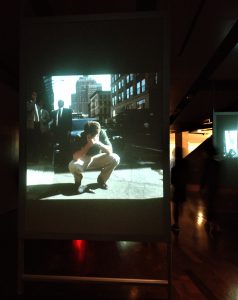
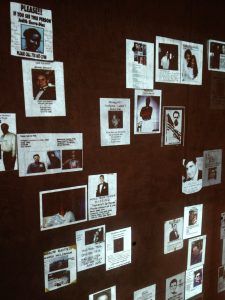
You go 70 feet below ground to the Center Passage to see the Ladder Company 3  Truck, which was used by 11 brave firefighters who requested dispatch to the scene, although they had just finished a night shift. The truck was crushed and burned when the North Tower collapsed, and all 11 heroes died in the fall. Here too are the exposed box columns, which anchored the North Tower.
Truck, which was used by 11 brave firefighters who requested dispatch to the scene, although they had just finished a night shift. The truck was crushed and burned when the North Tower collapsed, and all 11 heroes died in the fall. Here too are the exposed box columns, which anchored the North Tower.
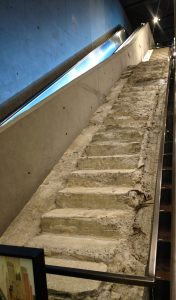 Located in the nearby Memorial Hall, which sits between the footprints of the North and South Towers, are the “survivors’ stairs”: a set of covered steps that were not in the original building plans, but put in almost as an afterthought, and provided a safe escape avenue for hundreds of people. Pictures of the victims line the walls. Here is the tiled blue paper wall with the unidentified victims resting behind it. Once you realize what this is, you understand better the hallowed atmosphere of the place, and it makes you want to cry. As DNA recognition improves, the victims are slowly being identified – they just discovered the identity of one of them last year.
Located in the nearby Memorial Hall, which sits between the footprints of the North and South Towers, are the “survivors’ stairs”: a set of covered steps that were not in the original building plans, but put in almost as an afterthought, and provided a safe escape avenue for hundreds of people. Pictures of the victims line the walls. Here is the tiled blue paper wall with the unidentified victims resting behind it. Once you realize what this is, you understand better the hallowed atmosphere of the place, and it makes you want to cry. As DNA recognition improves, the victims are slowly being identified – they just discovered the identity of one of them last year. 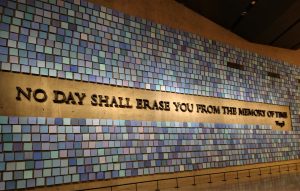
Around back of the Historical Exhibition (the biggest section with 3,000 artifacts) is the Foundation Hall, which houses the last column to be cut from the site in 2002, the “notes of hope” where you can write a remembrance, and the shirt of a SEAL Team Six member who was present in the raid and elimination of Osama bin Laden. Here too stands the Slurry Wall, which kept the Hudson River from flooding the site. Interesting fact, the slurry wall now has a slurry wall to support it.
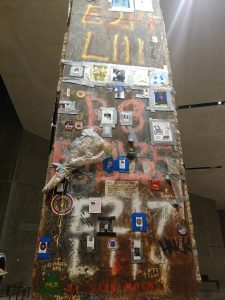
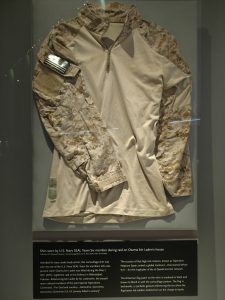

If you are in a time crunch, make sure you don’t get caught up too much in the exterior artifacts, because the number of pieces here pales in comparison to the amount of material in the chronologically organized Historical Exhibition. Unfortunately, pictures are not allowed, and as I try to be a rule-player, I didn’t sneak any. I will quickly outline the things that stand out in my mind.
- The schedule for Mayor Giuliani that day, listing his events and under each one the haunting words in bold: “cancelled, due to terrorist attack.”
- The voice recordings I described above- pick up the phones on the walls to hear them.
- The closest camerawork I have ever seen of the second attack, a video of Flight 175 crashing into the South Tower, and emitting fire. You can see a part of the plane flying out the other side.
- The red bandana of 24-year-old Welles Crowther, who ran up and down rescuing people, until he finally died.
- The picture of a group who refused to leave a handicapped coworker behind, and struggled to carry him to safety.
- Pictures of jumpers in various stages of falling.
- The details of a young mother who held her skirt as she jumped- her last act of dignity.
- The sapphire-and-diamond ring of a woman who bought it as commemoration for surviving the 1993 parking lot bombing. It was found on her finger after she died in the 2001 attack.
- A huge, metal support beam from one of the towers, bent into a question mark shape from the heat.
- Clothing from two young children who were aboard the plane that struck the pentagon.
- Video footage from news organizations around the world, reporting the attacks in their languages.
- A burned-up ambulance, into which people dove to escape the heat of the second strike.
- The collar and leash of Sirius the bomb-sniffing dog, who was locked in a South Tower kennel when his handler went to assist after the North Tower attack. The handler’s later request to go in after Sirius was denied. Sirius’ remains were later recovered and given an honor burial.
- The haunting threat of a terrorist after the 1993 bombing, stating that they would target the towers again.
There are thousands of artifacts and pictures in this museum. There is also a very succinctly educational section about Islamic terrorism, and the differences between the various factions- Al Qaeda, the Taliban, etc. Len and I were on a schedule, so we could not soak this section in properly, as it is toward the back of the exhibit. I encourage all visitors to give yourselves time here. The entire experience is educational, but this section has real-time application.
I recommend going to the Memorial Plaza outside after you finish, because it will simply mean more to you then. This is the area with the two
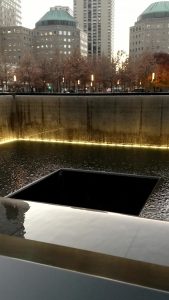 waterfalls, over the site of the two towers. Around the edges are engraved the names of the victims from that day.
waterfalls, over the site of the two towers. Around the edges are engraved the names of the victims from that day.
You can choose from a range of guided tours, and I strongly suggest you do so. All the options are on the website. I cannot stress enough the haunting beauty and patriotic fervor of the museum, and will return when I next find myself in the iron-willed city of New York.






